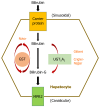Gilbert's syndrome: The good, the bad and the ugly
- PMID: 40027563
- PMCID: PMC11866151
- DOI: 10.4254/wjh.v17.i2.98503
Gilbert's syndrome: The good, the bad and the ugly
Abstract
Gilbert's syndrome (GS) is a common hereditary condition characterized by mild increases in serum bilirubin levels due to inherited defects in bilirubin metabolism. This review, based on peer-reviewed articles spanning from 1977 to January 2024 and sourced through the PubMed platform, provides an overview of current knowledge regarding GS. Early studies primarily focused on defining the clinical and genetic characteristics of the syndrome. More recent research has delved into the genetic mechanisms underlying the reduced expression of bilirubin UDP-glucuronosyltransferase, significantly enhancing our understanding of the pathogenesis of GS. Recent studies have also investigated clinical implications of GS, including its association with metabolic associated steatotic liver disease, cardiovascular disease, mental health and mortality risk, highlighting the complex interplay between genetic factors, bilirubin metabolism, and clinical outcomes.
Keywords: Clinical implications; Drug metabolism; Genetic variations; Gilbert’s syndrome; Protective effects.
©The Author(s) 2025. Published by Baishideng Publishing Group Inc. All rights reserved.
Conflict of interest statement
Conflict-of-interest statement: All the authors report no relevant conflicts of interest for this article.
Figures

References
-
- Wagner KH, Shiels RG, Lang CA, Seyed Khoei N, Bulmer AC. Diagnostic criteria and contributors to Gilbert's syndrome. Crit Rev Clin Lab Sci. 2018;55:129–139. - PubMed
-
- Vítek L, Tiribelli C. Gilbert's syndrome revisited. J Hepatol. 2023;79:1049–1055. - PubMed
-
- Huppertz LM, Gunsilius L, Lardi C, Weinmann W, Thierauf-Emberger A. Influence of Gilbert's syndrome on the formation of ethyl glucuronide. Int J Legal Med. 2015;129:1005–1010. - PubMed
Publication types
LinkOut - more resources
Full Text Sources
Research Materials

